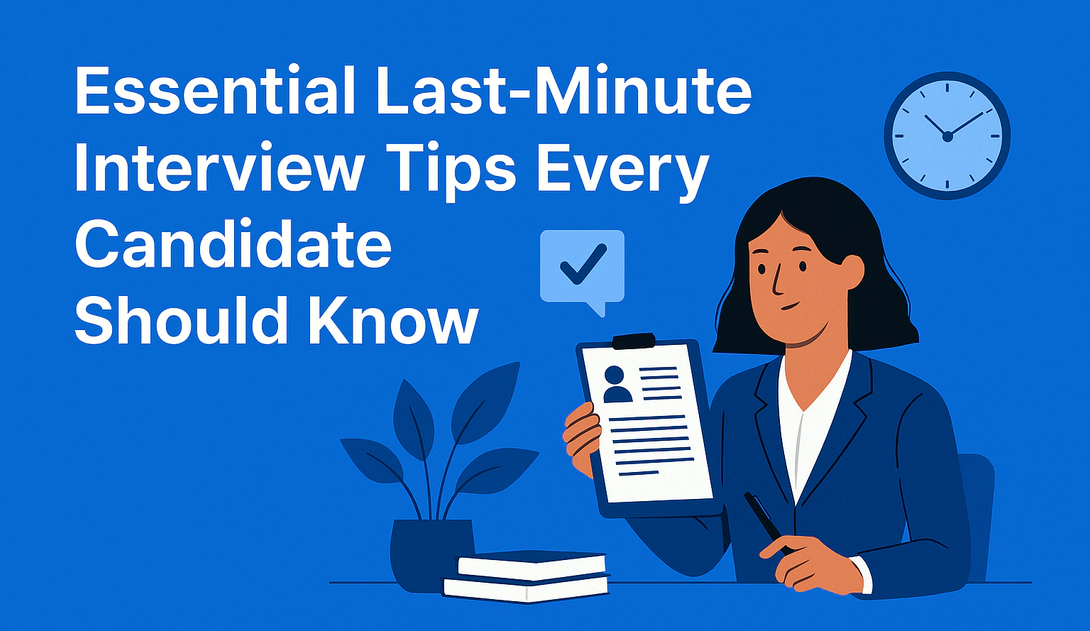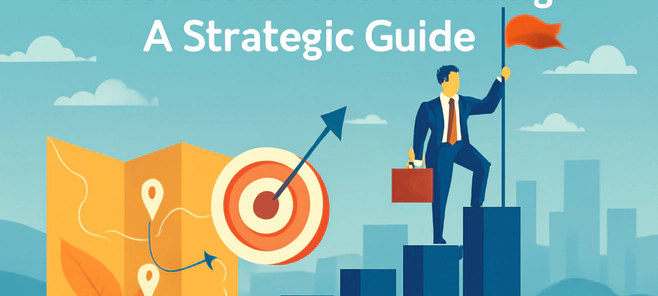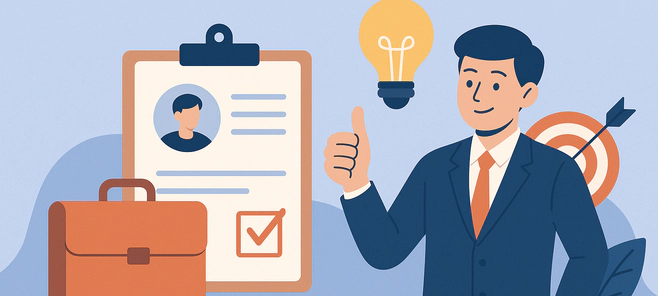Preparing for a job interview is a multi-step journey: writing your resume (often called a CV outside the US), sending applications, researching companies, and practicing answers. Yet many candidates overlook the final stage that ties everything together. These last steps - the last-minute interview preparation - can be the difference between blending in and standing out.
It’s not easy to land an interview invitation. For a single opening, there may be hundreds or even thousands of applicants. If you have been selected, you already stand out. Now your task is to maximize that opportunity by polishing the final details so nothing small undermines all your hard work.
What Is Last-Minute Interview Preparation?
The term “last-minute” does not cover your entire job search. That broader process includes drafting your resume, submitting applications, completing assessments, and practicing interview techniques. Last-minute preparation refers to the final 1-3 days before your interview, when you refine your answers, gather documents, plan logistics, and align your mindset.
Think of it as the finishing touch on something you have already built. The foundation - your skills, achievements, and research - is in place. Now you ensure that every visible detail supports a strong first impression.
Why This Stage Matters
Presentation shapes perception. The best qualifications can be overshadowed by poor organisation, unfocused answers, or preventable delays. Conversely, candidates with similar experience can pull ahead by appearing prepared, calm, and structured. Last-minute preparation amplifies what you already have and reduces avoidable risks.
The Four Pillars Of Last-Minute Preparation
- Information collection - the essentials you must know about the company, role, and interviewers.
- Personal preparation - your answers, examples, and delivery.
- Documents and essentials - what to bring and how to present yourself.
- Logistics and planning - timing, location, tech checks, and contingencies.
Each pillar contributes to your confidence and clarity. Below, you will find a practical, step-by-step guide with examples and checklists.
1. Information Collection
Research the organisation
Interviewers want evidence of genuine interest. Be ready to answer: What do you know about us? Why here? Scan the company site, press releases, and recent updates. Capture a few crisp points in your notes:
- Mission, values, and culture.
- Products or services and who they serve.
- Market position, competitors, or recent milestones.
- Any relevant news tied to your function or team.
Understand the job details
Go beyond the title. Read the description line by line and identify how your experience maps to the role. Prepare a brief link between each requirement and a skill or example you possess. You will use these links when answering Why are you a good fit?
Know your interviewers (if available)
Look up interviewers on LinkedIn or the company page. Note their function, seniority, and potential focus areas. This helps you anticipate questions and reference shared interests or relevant work. Keep it professional - your goal is context, not personal details.
2. Personal Preparation
Rehearse high-impact questions
Polish your answers to the questions that most influence the decision:
- Tell me about yourself - 60 to 90 seconds, role-aligned narrative.
- Why this company and role? - 2 to 3 reasons anchored in value you bring.
- Strengths and weaknesses - strengths backed by examples, a real weakness paired with what you are doing to improve.
- A challenging situation and outcome - use STAR (Situation, Task, Action, Result).
- Your impact in past roles - quantify when possible (metrics, timelines, scale).
STAR refresher in 30 seconds
- Situation - brief context.
- Task - your responsibility.
- Action - what you did specifically.
- Result - measurable outcome or lesson.
Keep STAR answers concise, focused on your contribution, and relevant to the new role.
Craft a sharp self-introduction
Structure a short opener you can deliver smoothly:
- 1 sentence on current role or focus.
- 1 to 2 sentences on relevant experience and key strengths.
- 1 sentence on why this role and the company.
Aim for clarity and natural delivery - avoid reading a script.
Mirror or camera practice
Speak out loud. Time yourself. Watch for filler words, speed, posture, and eye contact. Adjust until your delivery sounds confident and conversational. If possible, record a quick rehearsal and review once.
Prepare thoughtful questions for the interviewers
Strong questions communicate engagement and maturity. Examples:
- How does this role create value for the team in the next 6 months?
- What are the top 2-3 priorities for this position in the first quarter?
- How is success measured here?
- What does onboarding look like and who will I collaborate with most closely?
- How do you support learning and growth within the team?
3. Documents And Essentials
Organize your documents
Unless the company explicitly discourages printouts, bring:
- 2 to 3 copies of your resume.
- A concise one-page reference of key projects or achievements (optional).
- Any certificates or documents requested in the job posting.
- A small notebook and pen for quick notes.
Choose the right outfit
Your outfit sets a tone before you speak. Match the role and culture:
- Formal or managerial roles - suit or blazer, neutral shirt, dark trousers or skirt, plain tie if appropriate, polished shoes.
- Semi-formal roles - button-up shirt or blouse with trousers, chinos, or neat jeans; clean footwear.
- Casual environments - smart-casual, clean and well-fitted; avoid overly informal clothing.
Fit and neatness beat price. Ensure clothes are pressed, shoes are clean, and grooming is tidy. Keep accessories minimal and purposeful.
Small but important items
- A bag to keep everything organised.
- Water bottle - a sip can steady your voice.
- Tissues or a handkerchief.
- Light deodorant or fragrance (perfume/cologne).
- Breath mints or breath freshener before you enter.
- Backup charger or power bank if you expect a long process.
4. Logistics And Planning
Route and timing
Check the exact location, entry instructions, and building security steps. Plan to arrive 10-15 minutes early. Set a backup route in case of delays. If the location is unfamiliar, consider a quick dry run at a similar time of day.
Online interview setup
Virtual interviews require the same level of polish:
- Test internet, webcam, and microphone.
- Choose a quiet, well-lit room with a neutral background.
- Close unnecessary apps and notifications.
- Keep a backup connection if possible (mobile hotspot).
- Join the call a few minutes early to resolve any unexpected prompts or updates.
Environment control
Silence your phone. Notify household members or colleagues in advance. Place a glass of water within reach. Have your resume, notes, and job description open but out of camera view.
Day-Before And Day-Of Timeline
Day before
- Revisit the job description and map your top 5 experiences to the role.
- Print or prepare digital copies of your resume and any requested documents.
- Lay out your outfit and do a quick grooming check.
- Confirm the interview time zone, location, and contact person.
- Review your opener and 2 STAR stories you can adapt to multiple questions.
Morning of the interview
- Light meal and hydration.
- 10-minute vocal warm-up: read your opener out loud and one STAR answer.
- Quick posture reset: shoulders relaxed, deep belly breaths, calm pace.
- Leave with buffer time or join the virtual room early.
Common Pitfalls To Avoid
- Vague answers - replace generalities with concrete examples and metrics.
- Rambling - keep answers structured; if you drift, pause and reset.
- Over-apologising - acknowledge gaps briefly, then pivot to strengths and learning.
- Speaking negatively about past employers - keep it professional and forward-looking.
- Weak close - end with clear interest and 1 to 2 concise reasons you are a fit.
Quick Reference: Your 60-Second Close
Use this when the interviewer asks whether you have anything to add or at the end of the conversation:
- Reaffirm interest in the role and company.
- Tie 2 strengths to their priorities.
- Express appreciation and readiness for next steps.
Example: “Thanks for the conversation. I’m excited about contributing to X and Y because they align with my A and B strengths. I appreciate your time and I’m looking forward to the next steps.”
For Remote-First And Hybrid Teams
If the company values async collaboration, highlight how you:
- Structure updates and write clearly.
- Manage priorities across time zones.
- Proactively document decisions and share context.
- Use tools effectively (task boards, docs, short video recordings or screen shares).
Prepare a brief example of a remote project you drove successfully - the cadence, tools, and outcomes.
Quick Checklist Before You Leave Or Log In
- Resume and any requested documents packed or open.
- Outfit pressed and shoes clean.
- Grooming check: shave or trim, tidy hair, minimal accessories.
- Pen, notebook, tissues, mouth freshener, water.
- Route planned with a backup or video link tested.
- Phone silenced and notifications off.
- Two STAR stories fresh in mind.
- 60-second close ready.
Final Thought
An interview is more than a knowledge check - it is a moment to communicate value, clarity, and readiness. Last-minute preparation transforms solid experience into a compelling impression by aligning details, reducing risk, and boosting confidence. Many candidates underestimate this stage. You won’t. By following these steps, you will walk in prepared, centred, and ready to show exactly why you are the right fit.





